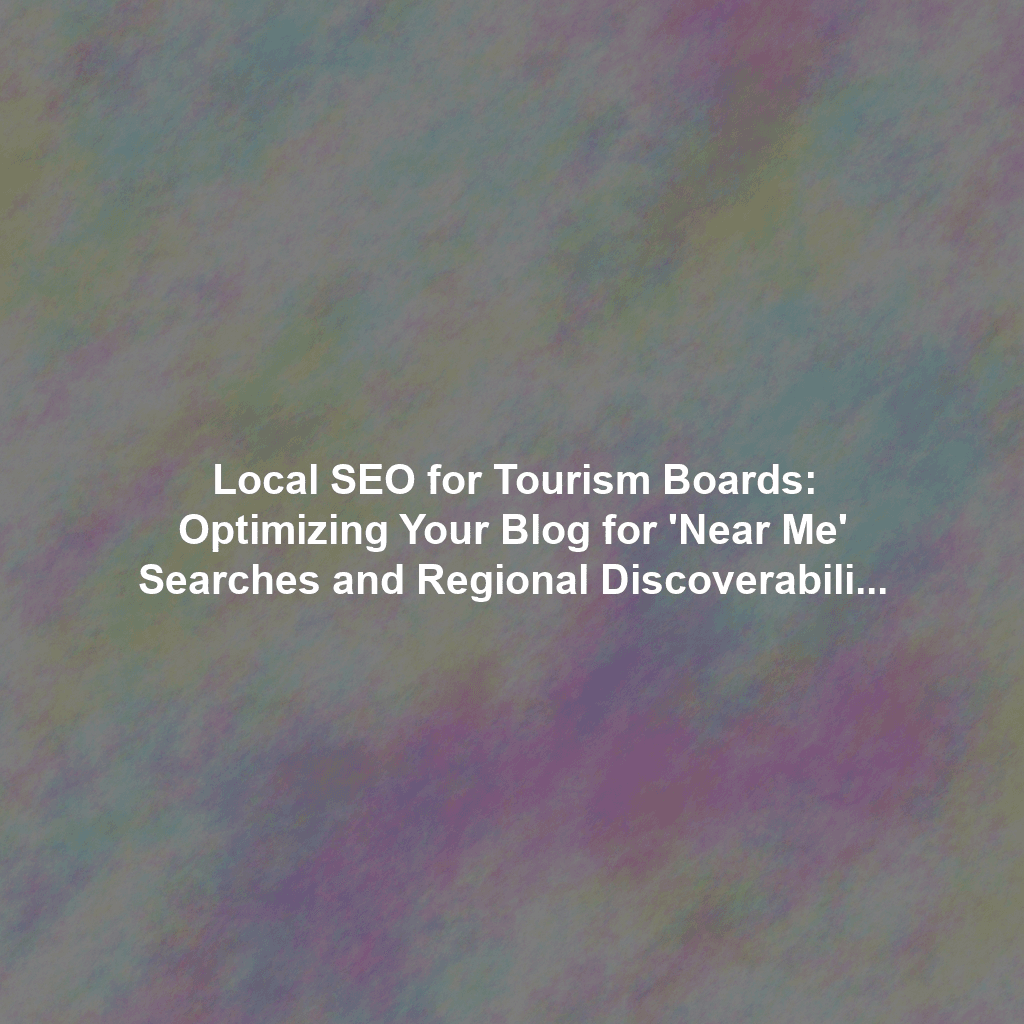Get More Tourists Through Your Digital Doors: How Your Blog Can Be Your Secret Local SEO Weapon (Forget Those Generic Travel Brochures)
Let’s cut the crap. If you’re running a tourism board, your whole damn existence hinges on one thing: getting more bodies to your destination. More visitors means more money flowing into local businesses, more buzz, more everything good. And in this day and age, if you’re not all over the digital landscape like a rash, you’re missing out on a massive chunk of potential travelers. Sure, those broad, sweeping SEO strategies about “best vacation spots” are fine and dandy, but if you’re not laser-focused on local SEO, you’re leaving money on the damn table. Local SEO is the key to capturing those precious travelers who are actively searching for experiences *right now*, “near me,” or within your specific neck of the woods. Think of it as tailoring your digital welcome mat to attract the very people who are already packing their bags (or at least thinking about it). This article is going to dive deep into how your blog content – yes, that often-neglected corner of your website – can become your secret weapon in the local SEO game, helping you pull in more visitors and show off exactly why your destination is the best damn place they could possibly visit.
Understanding Why Local SEO is the Holy Grail for Tourism (It’s Not Just About Looking Pretty Online)
Local SEO isn’t just some fancy tech jargon; it’s about making sure your online presence is screaming “Visit me!” to the people who are already planning a trip to your area. When someone whips out their phone and searches for “best damn pizza near [your city]” or “totally awesome things to do in [your region],” you want your destination – and the businesses within it – to be right there, front and center, like the star of the show. Ignoring local SEO is like putting up a “Closed for Business” sign to a huge chunk of potential visitors. These aren’t just casual browsers; these are people actively looking for information, comparing options, and ready to book flights, hotels, and activities. By getting your local SEO ducks in a row, tourism boards can:
- Be Seen Where It Matters (Increase Visibility in Local Search Results): We’re talking Google Maps, Bing Places, all those local search results that pop up when someone searches for something specific in your area. Being at the top of those results is like having prime real estate on the digital main street. Google’s guide to local business structured data highlights the importance of clear local information.
- Get More Clicks (Drive More Traffic to Their Website): Higher visibility in local search results naturally leads to more people clicking through to your website. And more website traffic means more opportunities to showcase what you’ve got and convert those visitors into actual tourists.
- Attract the Ready-to-Spend Crowd (Visitors Actively Searching for Local Experiences): These aren’t just dreamers; these are people with intent. They’re looking for hotels, restaurants, attractions, tours – the whole shebang. Local SEO puts you right in front of them when they’re actively making those decisions.
- Be a Good Neighbor (Build Stronger Relationships with Local Businesses): When your destination is more visible in local search, it benefits all the local businesses – hotels, restaurants, tour operators, shops. By working together on local SEO, you’re lifting the entire local economy. The U.S. Small Business Administration (SBA) offers resources for local economic development.
- Look Like the Real Deal (Enhance the Overall Perception of the Destination): A strong online presence in local search results builds trust and credibility. It shows that your destination is well-organized, has plenty to offer, and is easy for visitors to find and explore.
Turning Your Blog into a Local SEO Powerhouse (It’s Not Just Fluffy Travel Tales)
Your blog isn’t just a place to share pretty pictures and write about the best sunsets (though those are nice too). It’s a seriously powerful tool for local SEO. By creating informative and engaging content that’s strategically optimized with local keywords, you can significantly boost your visibility in search results and attract those eager travelers.
Speaking the Local Language (Targeting Geographically Relevant Keywords Like a Pro)
Keyword research isn’t just a one-time thing; it’s the damn foundation of any solid SEO strategy, especially local SEO. You need to think like a traveler who’s already decided they’re coming to your area. Instead of just targeting broad terms like “best hiking trails,” you need to get specific. Think “best hiking trails near [Your Town, State]” or “[Your Region] hiking spots with scenic overlooks.” It’s all about adding that crucial local flavor to your keywords.
Here’s your toolkit for finding those golden local keywords:
- Google’s Free Treasure Map (Google Keyword Planner): This free tool from Google is your starting point. It lets you research keyword volume (how many people are searching for it) and competition (how hard it might be to rank for it). Access Google Keyword Planner (requires a Google Ads account, but you don’t need to run ads to use it).
- Seeing What’s Hot Locally (Google Trends): Explore trending searches specifically related to your destination. This can uncover seasonal interests or emerging attractions that you can create content around. Explore Google Trends.
- Spying on the Competition (Competitor Analysis): Take a look at what keywords other tourism boards or local businesses in your area are targeting. What kind of content are they creating that’s ranking well? Tools like SEMrush or Ahrefs (paid options) can help with this, but even a simple Google search can give you some clues.
- Thinking Like a Local (The Power of “Near Me” Searches): Pay close attention to the types of “near me” searches people are actually using. Think “hotels near me with a pool,” “best brunch near me outdoor seating,” “museums near me open late.” These “near me” searches signal a high level of intent – these people are ready to go, right now.
- Getting Specific (The Beauty of Long-Tail Keywords): Don’t just go for the broad, high-volume keywords. Target those longer, more specific phrases that address a user’s exact intent. For example, instead of “things to do in [Your City],” aim for “family-friendly activities in [Your City] for toddlers on a rainy day.” These long-tail keywords often have lower competition and can attract highly qualified traffic. Moz’s guide on long-tail keywords provides a good explanation.
Once you’ve got your list of juicy local keywords, the next step is to strategically weave them into your blog content. But remember, it needs to sound natural and authentic – don’t just stuff keywords in for the sake of it. Focus on creating valuable content that actually answers people’s questions and provides useful information. Incorporate your keywords in key areas like:
- The Eye-Catching Title (Page Titles and Headings): Make sure your primary keywords are in your page titles (the title tag that appears in search results) and your main headings (H1, H2, etc.) within the body of your blog post.
- The Snippet That Sells (Meta Descriptions): Write compelling meta descriptions (the short snippets of text that appear below the title in search results) that include your target keywords and entice people to click.
- Describing Your Visuals (Image Alt Text): When you upload images to your blog, use descriptive alt text that includes relevant keywords. This helps search engines understand what your images are about and can also improve accessibility.
- The Meat of Your Content (Body Text): Naturally incorporate your keywords throughout the body of your blog post as you provide valuable information to your readers. Don’t force it; focus on creating helpful, engaging content first.
Creating Your Local Digital Welcome Mats (Location-Specific Landing Pages That Convert)
While your blog posts can target specific local keywords, creating dedicated landing pages for key attractions, neighborhoods, or types of experiences is absolutely crucial for local SEO. Think of these pages as your digital welcome mats for specific aspects of your destination. These pages should be packed with detailed information, stunning high-quality images, and those all-important relevant local keywords. For example, if “[Your City]” is known for its historic district, you should have a dedicated landing page for “[Your City]’s Historic District” that highlights its history, key attractions, must-visit restaurants, and upcoming events.
Make sure each of these location-specific landing pages includes:
- Content That Hooks (Unique and Engaging Content): Don’t just provide a dry list of attractions. Tell a story, highlight what makes this location special, and use vivid language to paint a picture for potential visitors.
- Visual Eye Candy (High-Quality Images and Videos): Show, don’t just tell. Use breathtaking photos and engaging videos to showcase the beauty and appeal of this specific location.
- Tell Them What to Do (A Clear Call to Action): What do you want visitors to do next? “Book your tour now,” “Learn More about upcoming events,” “Find Hotels Nearby in this district” – make it clear and easy for them to take the next step.
- Help Them Find Their Way (Embedded Google Maps): Embed a Google Map showing the exact location of the attraction or district. This makes it easy for visitors to visualize where it is and plan their visit. Google’s guide to embedding maps.
- Real Talk (Reviews and Testimonials): If you have positive reviews or testimonials specifically about this attraction or area, feature them prominently on the page. This builds trust and social proof.
Getting Your Name Out There Locally (Building Local Citations That Matter)
Local citations are essentially online mentions of your tourism board’s name, address, and phone number (often abbreviated as NAP) on other websites. Think of them as digital breadcrumbs that help Google verify your business’s location and boost your local search ranking. The more consistent and high-quality citations you have, the more trustworthy you appear to search engines.
Focus on building citations on reputable local directories and websites that travelers might actually use, such as:
- The King of Reviews (Yelp): A popular platform for finding local businesses and reading reviews. Claim or create your business listing on Yelp.
- The Traveler’s Bible (TripAdvisor): A go-to resource for travelers planning trips and looking for recommendations. Manage your TripAdvisor listing.
- Supporting Local (Local Chambers of Commerce): Many local chambers of commerce have online directories of their members. Getting listed here can boost your local credibility. Find your local Chamber of Commerce.
- Niche Down (Industry-Specific Directories): Look for travel blogs, restaurant directories, or other websites that are specific to the tourism industry in your area.
- Local News Outlets (Local News Websites): If your tourism board gets mentioned in local news articles, make sure your NAP information is accurate. Some local news sites also have business directories.
The absolute key here is consistency. Make damn sure that your name, address, and phone number are exactly the same across all these citations. Even small inconsistencies can confuse search engines and negatively impact your local search ranking. Use the exact same formatting and spelling every single time.
Your Local Google Powerhouse (Utilizing Google Business Profile Like a Pro)
Your Google Business Profile (formerly Google My Business) is arguably the single most important tool in your local SEO arsenal. Claiming and fully optimizing your GBP listing is absolutely essential for improving your visibility in Google Maps and those crucial local search results. Think of it as your free billboard on Google.
Here’s how to make your GBP listing shine:
- Fill in Every Damn Blank (Complete All Sections): Don’t leave any stone unturned. Provide accurate and detailed information about your tourism board, including your address, phone number, website, hours of operation (if applicable), and any other relevant details.
- Pick Your Categories Wisely (Choose Relevant Categories): Select the categories that most accurately describe your tourism board and the services you offer. Google allows you to choose multiple categories, so be thorough.
- Show Off Your Goods (Add High-Quality Photos and Videos): This is your chance to really showcase the beauty and attractions of your destination. Use high-resolution, visually appealing photos and videos that will entice potential visitors.
- Tell Your Story (Write a Compelling Business Description): Highlight what makes your destination unique and why people should visit. Use engaging language and incorporate relevant local keywords naturally.
- The Power of Praise (Encourage Reviews): Positive Google reviews can significantly boost your local search ranking and build trust with potential visitors. Make it easy for people to leave reviews by sharing a direct link to your GBP listing.
- Be Responsive (Respond to Reviews Promptly): Whether the review is positive or negative, take the time to respond professionally and thoughtfully. This shows that you value customer feedback.
- Keep Them Updated (Use Google Posts): Regularly share updates, upcoming events, special offers, and news about your destination using Google Posts. This keeps your listing fresh and engaging.
- Be Helpful (Answer Questions): Regularly check the “Questions & Answers” section of your GBP listing and promptly answer any questions that potential visitors might have.
Keeping Score (Measuring and Analyzing Your Local SEO Performance)
You can’t improve what you don’t measure. Tracking your local SEO performance is absolutely crucial for understanding what’s working well and what needs some tweaking. Use tools like Google Analytics and Google Search Console to keep a close eye on your website traffic, keyword rankings, and other key metrics.
Pay attention to:
- Where Are They Coming From? (Website Traffic from Local Search): Monitor how much traffic is coming to your website from local search results in Google and other search engines.
- What Are They Searching For? (Keyword Rankings for Geographically Relevant Terms): Track where your website and specific pages are ranking for those important local keywords you identified earlier.
- Are They Clicking? (Click-Through Rates (CTR) from Local Search Results): See how often people are clicking on your website listing in local search results. A low CTR might indicate that your title tags or meta descriptions need improvement.
- Are They Sticking Around? (Engagement Metrics): Look at metrics like bounce rate (how quickly people leave your site) and time on page to see if your content is engaging your local audience.
- Are They Doing What You Want? (Conversion Rates): Track how many visitors from local search are actually taking the desired action, whether it’s booking an inquiry, downloading a brochure, or contacting you for more information.
Regularly analyze this data and be prepared to adjust your SEO strategy based on what the numbers are telling you.
In Conclusion: Become the Local Digital Magnet
Local SEO isn’t some optional extra for tourism boards; it’s a vital damn component of any successful destination marketing strategy in today’s digital world. By strategically optimizing your blog content for local search, you can attract more of those high-intent visitors, significantly increase your regional discoverability, and truly showcase the unique and unforgettable experiences that your destination has to offer. By focusing on those geographically relevant keywords, creating those welcoming location-specific landing pages, building a strong network of local citations, and effectively harnessing the power of your Google Business Profile, you can transform your online presence into a powerful magnet that draws in travelers who are actively searching for their next great adventure. So get to work, start optimizing, and watch those visitor numbers climb.
 Skip to content
Skip to content

